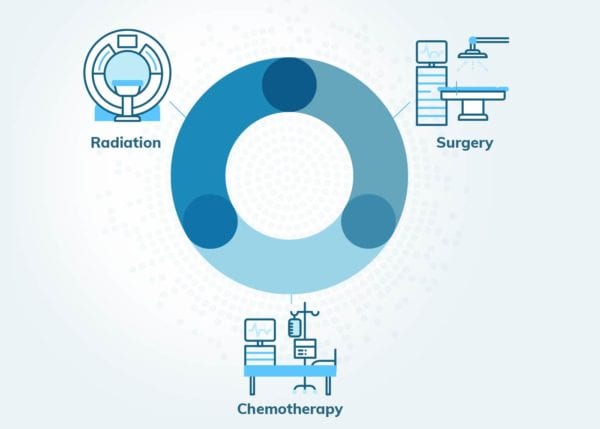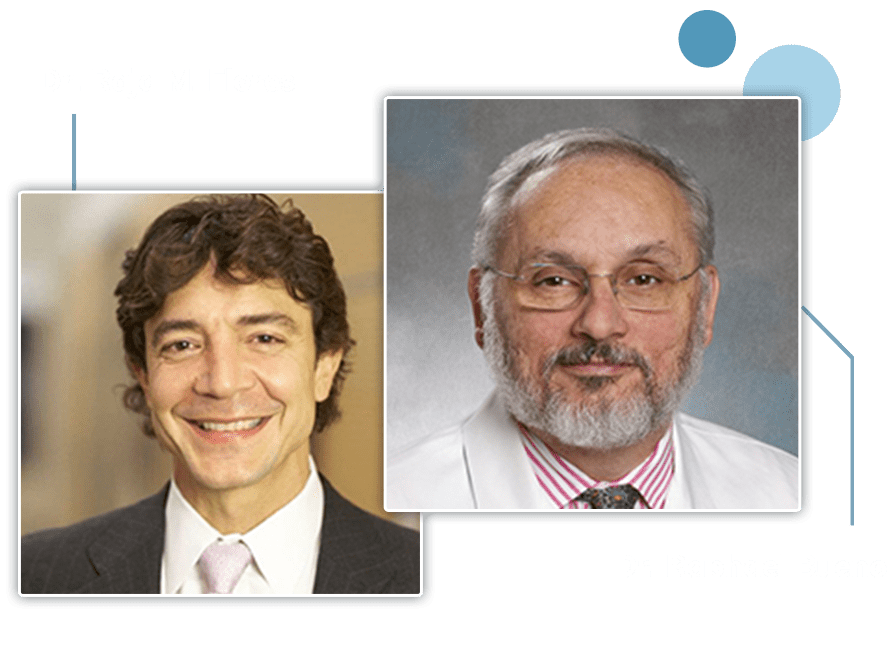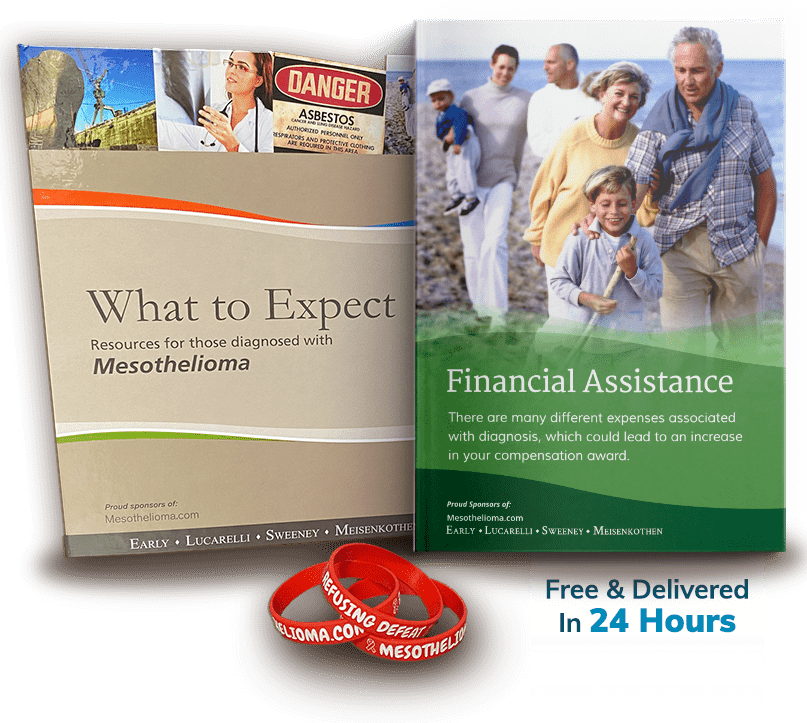01. Overview
How Multimodal Therapy Treats Mesothelioma
研究表明单一模式treatment for malignant mesotheliomahave limited success in improving survival. Without any form of treatment,万博专业版patients’ survival times range from four months to one year. For optimal patient outcomes, doctors may recommend multimodal treatment. Multimodal therapy uses one form of treatment as a primary therapy and may include treatment before and after the main therapy to improve outcomes.
- Neoadjuvant Therapy:治疗given prior to the primary therapy to enhance efficacy.
- Primary Therapy:This therapy option is believed to be the best treatment. For mesothelioma, this is often surgery.
- Adjuvant Therapy:治疗given after the primary therapy to reduce risk of recurrence.
间皮瘤多模式疗法的顺序将根万博专业版据疾病,细胞类型和患者的一般健康状况而有所不同。在考虑了这些特征之后,医生将确定每种治疗的最佳顺序和剂量。研究表明,间皮瘤患者从多模式疗万博专业版法中受益最大的患者包括epithelial cell type, negative resection margins (no presence of cancer cells in the tissues around where the tumor developed) and nometastaseswithin the lymph nodes.
02. Therapy Components
Components of Multimodal Therapy
多模式疗法涉及两种或多种治疗模式的组合。最常见的是间皮瘤,这将是万博专业版chemotherapy,surgeryandradiationadministered in various orders. Other novel treatments like immunotherapy may also be used for either curative or palliative gains.
The order in which the treatments are administered varies by the mesothelioma treatment center and an individual’s case. A patient’s stage of disease, cell type and overall health are all factors used to determine the most effective treatment order for their diagnosis.
Although courses of treatment for patients may vary, researchers have found certain treatment combinations that have effectively improved life expectancy. Forpleural mesothelioma, one of the most common multimodal approaches entails surgery, including anextrapleural pneumonectomy(EPP) orpleurectomy/decortication(P/D), followed by adjuvant chemotherapy and radiation. For many patients, surgery is performed first to remove as much cancerous tissue as possible, followed by a course of chemotherapy four to six weeks later. Radiation may then be administered over the course of several weeks. In some studies, this combination treatment has been found to prolong mesothelioma patient survival time up to 23.9 months, compared to six months to one year without this treatment, and doctors continue to test different combinations of these treatments to improve efficacy.
Though surgery combined with chemotherapy and radiation is considered a standard of care for pleural mesothelioma, researchers have also been testing other combination therapies like intracavitary photodynamic therapy (PDT) and intracavitary chemotherapy. PDT is light-based treatment, which produces oxygen that in turn kills the cancerous tumors. When used after P/D, researchers found that PDT led to a median survival of 58 months for patients with epithelioid mesothelioma. Intracavitary chemotherapy involves chemotherapy delivered directly into the body’s cavity, such as the pleura, instead of intravenously. Administering the chemotherapy in this way enables the use of higher doses. Mesothelioma treated with EPP or P/D followed by intracavitary chemotherapy has a median overall survival of 35 months.
免疫疗法has also been a focus of many mesothelioma clinical trials, applied as singular treatments or in multimodal plans. Currently, researchers are considering the promise of combining immunotherapy and chemotherapy to treat pleural mesothelioma. One recent clinical trial testing immunotherapy drug Ad.IFN with chemotherapy found an overall response rate of 25%, with an 88% disease control rate, meaning patients didn’t experience metastasis or spreading of the cancer. More than 60% of the patients in the trial achieved stable disease after treatment.
For patients withperitoneal mesothelioma, the preferred multimodal treatment also includes surgery, when viable. Cytoreductive surgery, which focuses on removing all cancerous tissues and impacted organs, followed by a heated chemotherapy wash calledhyperthermic intraperitoneal chemotherapy,或HIPEC在治疗癌症方面最成功。HIPEC涉及加热化疗药物并将其循环到整个患者的腹部,以杀死任何剩余的癌细胞。在疾病早期被诊断出,手术和HIPEC是腹膜间皮瘤的护理标准。万博专业版
According to results from one recent study, patients with malignant peritoneal mesothelioma treated in this way achieved a median overall survival of 53 months. Of the 401 patients analyzed, more than 80% had 1-year survival and 47% experienced 5-year survival. Other clinical trials have found similar success, with one noting patients surviving 92 months or longer. Without this treatment combination, patients typically live six months to one year following diagnosis.
Resources for Mesothelioma Patients
03. Success Rate
多模式疗法的成功率
Success following multimodal therapy can vary based on order of treatment, dosage and the individual patient. However, studies have shown multimodal treatment can reduce recurrence and extend survival for some patients.
The ability to reduce recurrence rates among mesothelioma patients undergoing multimodal therapy has increased the appeal of the particular treatment type, since cancer recurrence is common with all forms of mesothelioma. Researchers have found that certain multimodal treatments may help reduce recurrence rates. One study found that intensity-modulated radiation therapy (IMRT) as an adjuvant therapy following an extrapleural pneumonectomy decreased local recurrence rates. The study found only 14% of patients that received IMRT had local recurrence, compared to 42% that received the typical form of radiation.
For patients who are not candidates for radiation, adjuvant chemotherapy is another promising treatment option to improve recurrence rate and overall survival. A retrospective study found that on average, mesothelioma patients that underwent surgery alone experienced recurrence 10 months after their treatment. The patients that had surgery followed by chemotherapy did not experience recurrence for an average of 37 months.
此外,研究人员得出的结论是,与仅手术相比,辅助系统化疗可改善患者的生存率。接受手术和化疗的51例患者的平均存活率为35个月。仅接受手术治疗的13名患者的平均存活率为13个月。
虽然已经有了可喜的成果various multimodality treatments, researchers are continuing to test new combinations, doses and orders to improve patient recurrence and survival rates.
04. Eligibility
Multimodal Treatment Eligibility
万博专业版间皮瘤多模式治疗是一个非常aggressive treatment plan that may not be suitable for all patients. Additionally, newer treatment options included in multimodal therapy, like immunotherapy, are currently only available in clinical trials, meaning patients interested in receiving these treatments would have to be eligible for the various trials.
To undergo the trimodal therapy (chemotherapy, surgery and radiation), patients must be strong enough to heal properly following surgery, endure the toxicity of chemotherapy and be able to safely receive radiation treatments. Patients who may have had radiation treatments in the past may have reached the limit that the body can safely tolerate, making the treatment option no longer viable. Mesothelioma patients undergoing multimodality treatment may experienceside effects与用于其案件的每个治疗方案相关联。
When a patient’s care team is combining treatments, they must consider how the treatments interact and impact one another. Doctors consider side effects that may result following each treatment and how that may impact the efficacy of the following therapies, but also how the therapies may eliminate future treatment options. These potential trade-offs must be considered by a patient’s care team when determining the best treatment options for an individual’s case.








